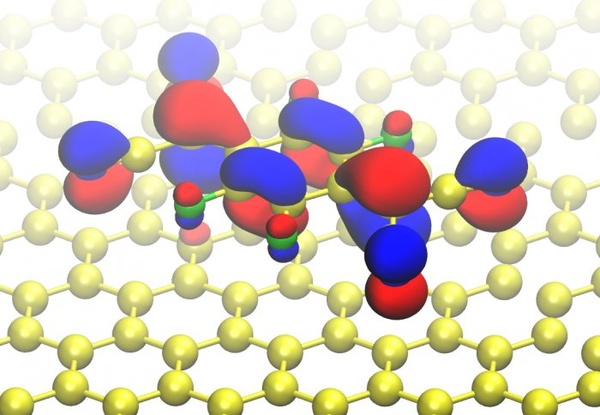|
researchers at the university of california-berkeley and imperial college london have developed a means for controlling the charge state of single organic molecules that have been attached to graphene sheets, which could be used as molecular switches in electronic devices, according to a report from imperial college.

scientists were able to control the charge state of a molecule on a graphene sheet. (imperial college)
the report noted, “switches are important in electronic devices that store information, such as hard drives, where the sequence of ‘on’ or ‘off’ positions of the switch encodes information, in a similar way to the 1s and 0s of digital information.”
the researchers used a molecule of tetrafluorotetracyanoquinodimethane (f4-tcnq) on a graphene sheet and used an electrical field to increase the graphene’s electron density. the graphene donated some of its electrons to the organic f4-tcnq, which changed its charge state.
being able to control a molecule’s charge state could turn it into a microscopic switch and scientists are hopeful that this discovery could be used to create more efficient storage devices such as usb or memory sticks and in biological sensors.
the researchers will now begin investigating pairs and assemblies of molecules and ways to anchor single molecules to graphene sheets in order to make manufacturing devices easier.
the work was published in nature communications. the abstract stated:
“the ability to understand and control the electronic properties of individual molecules in a device environment is crucial for developing future technologies at the nanometre scale and below. achieving this, however, requires the creation of three-terminal devices that allow single molecules to be both gated and imaged at the atomic scale.
“we have accomplished this by integrating a graphene field effect transistor with a scanning tunnelling microscope, thus allowing gate-controlled charging and spectroscopic interrogation of individual tetrafluoro-tetracyanoquinodimethane molecules. we observe a non-rigid shift in the molecule’s lowest unoccupied molecular orbital energy (relative to the dirac point) as a function of gate voltage due to graphene polarization effects.
“our results show that electron–electron interactions play an important role in how molecular energy levels align to the graphene dirac point, and may significantly influence charge transport through individual molecules incorporated in graphene-based nanodevices.”
|